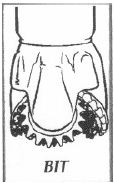نمایش نتیجه 1 تا 10 از 196 نتیجه یافت شده برای cone:
n: a roller cone bit that is specially designed for air or gas drilling. It is very similar to a regular bit, but features screens over the bearings to protect them from clogging with cuttings and thicker hardfacing on the shirttail to protect them from abrasive, high-velocity air or gas drilling fluid.
مخروط آبرفتی
n: The angle formed by two aspects of chisel teeth
of cone bit.
n: See ball bearing of cone.
n: Composed by several balls installed in the cone bearing and tray bath in the surface of cone axis. Used for sustaining radial reacting force of cone and part of axial force. Also can lock the cone and make sure it not fall off from the cone.
n: The assemblage opening in palm journal of cone bit. The weld line after cone ball is installed and the ball retaining plug is inserted.
n: Installed in the assemblage opening of cone journal. Used to prevent ball dropping out of the track.
n: Installed in the bearing race of cone. There are a ball bearing and two roller bearing in every cone, both absorbing radial load.
n: the cutting or boring element used in drilling oil and gas wells. The bit consists of a cutting element and a circulating element. The cutting element is steel teeth, tungsten carbide buttons, industrial diamonds, or polycrystalline diamonds (PDCs). The circulating element permits the passage of drilling fluid and utilises the hydraulic force of the fluid stream to improve drilling rates. In rotary drilling, several drill collars are joined to the bottom end of the drill pipe column, and the bit is attached to the end of the drill collars.
a drill bit, commonly either a roller cone, button bit, PDC, diamond or drag bit, used with a rotary string or a mud motor to drill through rock.
سرمته
n: on a roller cone bit, a coneshaped steel device from which the manufacturer either mills or forges steel teeth, or into which the manufacturer inserts tungsten carbide buttons. Most roller cone bits have three cones, which roll, or rotate, on bearings as the bit rotates. As the cones roll over the formation, the cutters on the cone scrape or gouge the formation to remove the rock.





